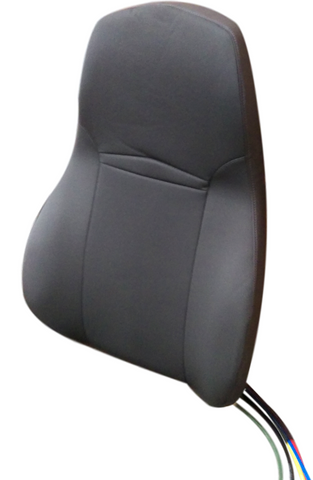Taking care of your semi truck seat upholstery is essential to ensuring comfort, maintaining the appearance of your vehicle, and prolonging the life of your seats. With proper maintenance and cleaning techniques, you can keep your truck seat upholstery looking new for years to come. In this guide, we will cover tips and tricks on how to care for your truck upholstery effectively. From regular cleaning routines to using appropriate products, we’ll help you keep your seats in top condition.
The Different Types of Truck Seat Upholstery
Truck interior upholstery comes in a variety of materials, each with its own benefits and maintenance requirements. From durable vinyl and leather to comfortable cloth and luxurious suede, there are several options to choose from when it comes to truck seat upholstery. Each type of upholstery for trucks also has its own specific cleaning processes.
Leather
Leather is synonymous with luxury. Its fresh smell is desired by many drivers. As durable as it is, leather upholstery maintenance is not difficult to maintain. You should regularly wipe it off with a clean, soft microfiber towel.
You should apply leather conditioner weekly to prevent the leather from drying out and cracking. Be sure to clean up accidental spills immediately. For sticky messes, you can use a mild detergent mixed in cold water. However, do not soak the seat and do use gentle circular motions to remove the sticky residue.
Most importantly, avoid using harsh cleaners, chemicals, and homemade cleaning solutions on leather seats. Furthermore, never use any type of cleaning pad on leather, like a scouring pad, as it can scratch and damage the leather.
Nylon/Polyester/Cloth

Nylon, polyester, and cloth truck seat upholstery materials are durable. They are stain- and tear-resistant. Seat covers can be removed and washed in a washing machine. Allow them to air dry or use low heat in a dryer.
The best way to clean upholstery of this type is to vacuum off the nylon, polyester, and cloth seats to remove dust, dirt, and crumbs. Remember to use a crevice tool to get down between seats.
If you have an accidental spill, do not rub it into the seat. Instead, blot up the excess wetness. Use a spot removal product for the type of material and follow the manufacturer’s directions once the spill has dried.
The spill can also be treated with detergent mixed in cold water. To rinse, use a clean damp cloth and continue to blot until the detergent is removed. Then let the seat dry on its own. You may need to use a commercial upholstery and carpet cleaner for difficult stains.
Vinyl
Vinyl is another truck upholstery that is easy to maintain and keep clean. While it can look like leather, you should never use leather cleaning and conditioning products on it. Nor should you use harsh chemicals and cleaners on vinyl.
Generally, it can be wiped clean with a damp towel or by using a cleaner formulated for vinyl surfaces to clean upholstery of this type. Just ensure you use a dry cloth to fully dry the seat after cleaning it.
You should also use a vacuum with a crevice tool to get in between the seats to remove dust, dirt, and crumbs. If you do not have access to a vacuum, you can use a soft-bristled brush to clean in between seats.
Caring for Your Seat Covers
As mentioned previously, nylon, cloth, and polyester truck seat covers can be washed in a washing machine by following the manufacturer’s guidelines to care for them. However, you do want to clean up spills right away.
Be sure to remove the seat cover and check the truck seat. If the truck seat is wet, clean up the spill and leave the seat cover off until the truck seat fully dries. Otherwise, you could get mold and mildew on your truck seat.
You can clean upholstery leather and vinyl seat covers and spot clean them using similar methods as you would for the same material type truck seat.
Repairing vs. Replacing Damaged Truck Seat Upholstery
Truck upholstery repair often involves getting a new truck seat cover or new truck seat. However, there are just two of your options. A third option you may want to consider when the damage is not significant is to repair the truck upholstery instead. Here are some of the pros and cons of repairing vs. replacing damaged truck seat upholstery.
Repairing Pros:
- Cost-effective option compared to replacing the entire seat
- Extends the life of your current seats if they are still structurally sound
Repairing Cons:
- Results may not look as seamless or lasting compared to a full replacement
- Limited in terms of repairing severe damage such as large tears or deep punctures
Replacing Pros:

- Provides a fresh, new look and feel to your truck’s interior
- Allows for custom truck upholstery such as material, color, and design options and other customizations like heating, cooling, and dual arm rests
- Ideal for extensive damage that cannot be easily repaired
Replacing Cons:
- Generally more expensive than repairs
- Old seats need to be disposed of in an environmentally responsible manner
Replacement Seats and Seat Covers for Your Truck
Even with the best care and maintenance upholstery for trucks, like semi truck seats and seat covers do eventually wear out. At that point, you can repair the upholstery, order replacement cushions, a new seat cover, or a brand new truck seat with custom truck upholstery and updated features like heating, cooling, and added lumbar support.
To find semi truck seats, seat covers, replacement parts for truck seats, and more, search or browse our online catalog, visit our showroom in Lodi, NJ, or call us at 844-727-7328 today to custom order a new truck seat or for further information and assistance.

